Here are some easy to grow shrubs for containers that will look fantastic on patios and balconies, alike!
These shrubs for containers are perfect for porches, balconies, gardens, and even indoors. Plus, they have a bushy growth, so they fill up the pot and make your home or garden look prettier and fuller.
Shrubs for Containers
1. Flowering Maple
Botanical Name: Abutilon
USDA Zones: 8-11
Pot Size: 12-18 inches
Flowering Maple needs just 6-8 hours of direct sunlight and it will give you gorgeous hollyhock-like flowers. This plant adapts well to container life, making it a low-maintenance choice.
2. Andromeda

Botanical Name: Andromeda polifolia
USDA Zones: 5-9
Pot Size: 14-18 inches
Andromeda can easily grow 2-4 feet tall and grows well in cool temperatures. It also has tiny pink flowers and is prized for its glossy foliage. It’s closely related to azaleas, rhododendrons, and mountain laurels.
3. Anisodontea
Botanical Name: Anisodontea
USDA Zones: 9-11
Pot Size: 12-16 inches
Anisodonteas grow in full sun and have absolutely gorgeous pink flowers. They’re great for balconies and porches. Anisodonteas are native to South Africa and can easily grow 6-10 feet tall. They are also heat and drought-tolerant.
4. Aster
Botanical Name: Aster
USDA Zones: 3-8
Pot Size: 10-14 inches
You can find Asters in tons of colors and they’re really easy to grow container shrubs. You can choose from Bushy Asters, New England Asters, and Smooth Asters. With proper care, they will reward you with a long season of blooms.
5. Spotted Laurel
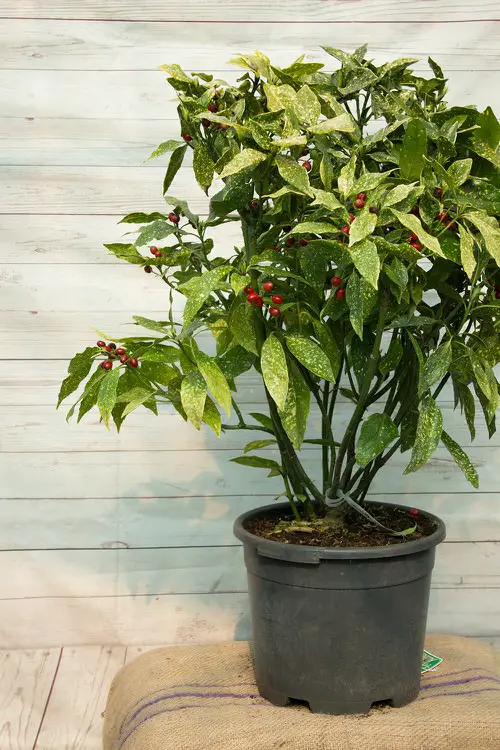
Botanical Name: Aucuba Japonica
USDA Zones: 7-10
Pot Size: 16-20 inches
Spotted Laurel has beautiful green foliage that’s covered in golden spots, earning it the name “Gold Dust.” It also produces small red berries. It’s native to rich forest soils of moist valleys, thickets, streams, and near shaded moist rocks in China, Korea, and Japan.
6. Azalea
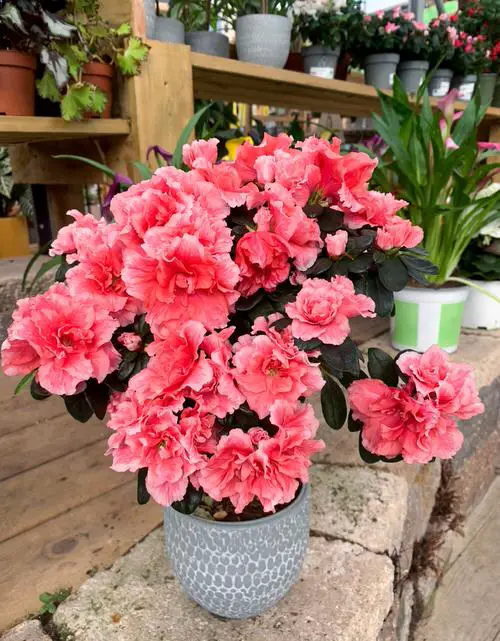
Botanical Name: Rhododendron
USDA Zones: 4-9
Pot Size: 10-16 inches
Azaleas are the most beautiful flowering shrubs for containers and have massive flowers. Just keep them safe from the harsh afternoon sun. Most of these bloom in spring (April and May in the Northern Hemisphere), with some reblooming varieties flowering again in summer or fall.
7. Bougainvillea
Botanical Name: Bougainvillea
USDA Zones: 9-12
Pot Size: 14-18 inches
Bougainvilleas need full sun for at least 6 hours a day. Their lovely pink, red, white, and yellow flowers will fill any container you plant them in. Did you know that Bougainvillea can be grown as a vine, a shrub, or even a bonsai tree?
8. Brugmansia
Botanical Name: Brugmansia
USDA Zones: 9-11
Pot Size: 18-24 inches
The flowers of Brugmansia shrubs smell great at night and attract many different pollinators. What more could you want from a shrub? You should be careful around it because all parts of Brugmansia are poisonous if ingested and can cause serious health problems or death.
9. Butterfly Bush
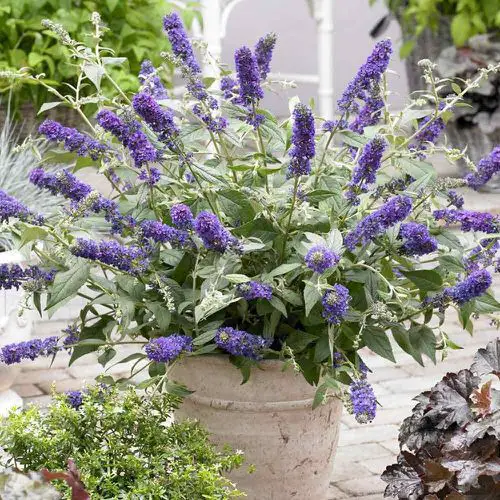
Botanical Name: Buddleia
USDA Zones: 5-11
Pot Size: 12-16 inches
Butterfly Bush has flowering panicles in white, red, pink, purple, and even blue. If you’re growing one in a container, you’ll need a dwarf variety. The best time to plant butterfly bushes is in spring or fall.
10. Boxwood
Botanical Name: Buxus
USDA Zones: 5-11
Pot Size: 10-14 inches
Boxwood is an adaptable and easy-to-grow shrub. It can tolerate a wide range of temperatures as well. Boxwood shrubs are a low-maintenance landscaping option that can add structure to your yard. They also thrive for many years.
11. Calamansi
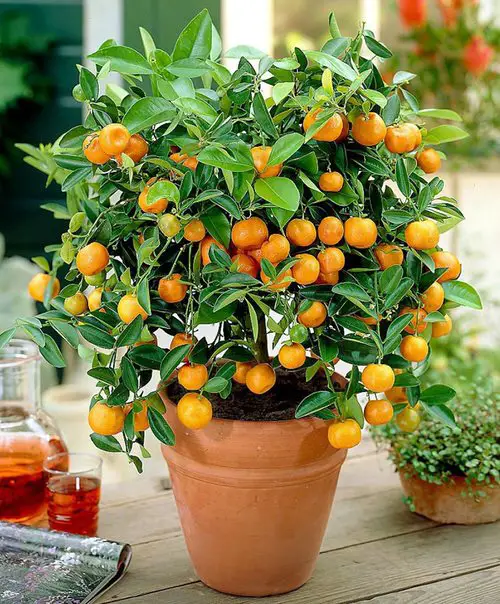
Botanical Name: Citrus × microcarpa
USDA Zones: 9-11
Pot Size: 12-16 inches
Calamansis stays compact and will even give you fruit if you give it enough sun. Don’t forget to prune it after fruiting. The fruit of the Calamansi resembles a small, round lime. It tastes like kumquat but with hints of citrus.
12. Bottlebrush

Botanical Name: Callistemon
USDA Zones: 8-11
Pot Size: 12-16 inches
Bottlebrush is a pollinator favorite and looks lovely with its red flowers. You can also find it in pink, yellow, and white. Bottlebrush shrubs are relatively low-maintenance and easy to care for. They are drought-tolerant once established, but you will need to give them occasional watering during dry periods.
13. Camellia
Botanical Name: Camellia japonica
USDA Zones: 7-9
Pot Size: 14-18 inches
Camellias are popular ornamental plants and are often used in landscaping and as container plants. These shrubs for containers need partial shade. If you’re growing it indoors, give it filtered sunlight through a curtain.
14. Rock Rose
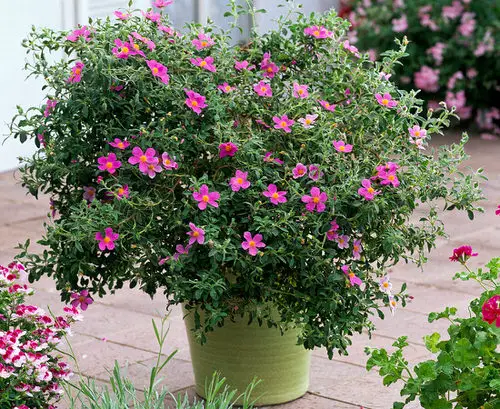
Botanical Name: Cistus
USDA Zones: 8-11
Pot Size: 10-14 inches
Rock Roses are actually Mediterranean shrubs that are really tough and drought-tolerant. Plant them once and skip the care because they can thrive on neglect. These shrubs are hardy, deer-resistant, and withstand extreme heat, too. They also grow well in poor-quality soils where other plants can’t.
15. Lemon
Botanical Name: Citrus limon
USDA Zones: 10-11
Pot Size: 18-24 inches
Who wouldn’t want to grow and relish their own lemons? All you need is a Lemon shrub growing in a container. Here’s how to grow this shrub or small tree.
16. Cotoneaster

Botanical Name: Cotoneaster
USDA Zones: 5-8
Pot Size: 10-14 inches
Cotoneaster is usually grown as a ground cover or in hedges in the gardens, but it can also be grown as a container plant. You’ll need a large container because it spreads a lot! But you can choose upright or wall Cotoneasters instead of spreading ones.
17. Daphne
Botanical Name: Daphne
USDA Zones: 4-8
Pot Size: 10-12 inches
Daphne shrubs should be kept in partial shade. Plus, they love moist soil, so don’t forget to water them properly. They’ll produce lovely small flower clusters for you. Many of these shrubs are also used to make paper.
18. Silverberry

Botanical Name: Elaeagnus
USDA Zones: 2-11
Pot Size: 14-18 inches
Silverberry is a drought-tolerant container shrub with beautiful silver-green foliage. It loves to grow without much maintenance and is a great choice for coastal areas. They are resistant to pests and diseases, and their fast growth rate makes them great for creating privacy screens or hedges.
19. Escallonia
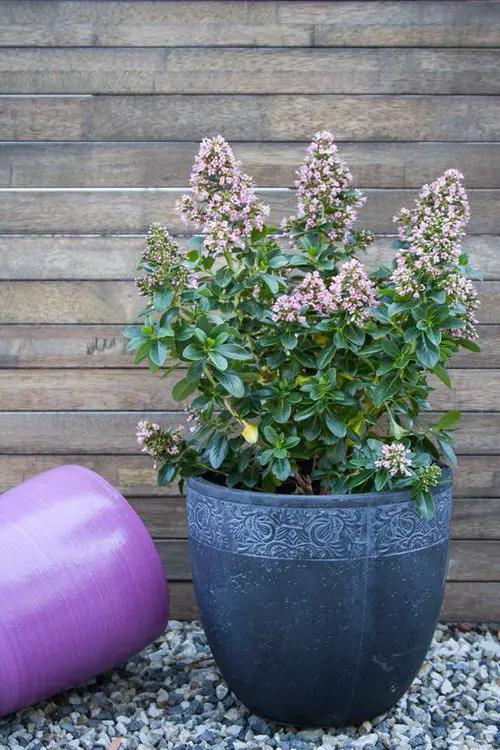
Botanical Name: Escallonia
USDA Zones: 8-10
Pot Size: 12-16 inches
Escalonias are beautiful, decorative, and have fragrant foliage–all three things you need from a shrub growing in a container. Plus, they’ll give you pretty flowers. Escallonia shrubs are also known for their salt tolerance, making them a lovely choice for coastal gardens.
20. Forsythia
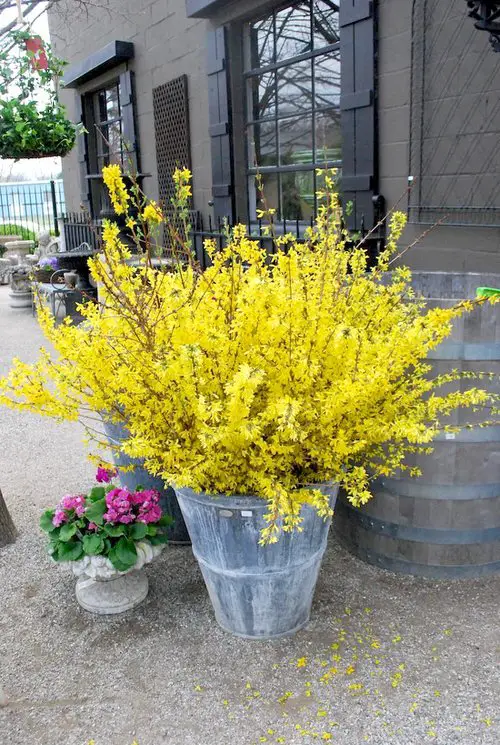
Botanical Name: Forsythia
USDA Zones: 4-9
Pot Size: 12-16 inches
Look for dwarf Forsythias for container growing. These shrubs are not fussy about soil types and need plenty of sunlight. They are well-known for their bright yellow flowers that bloom in early spring, often before the leaves emerge. This makes them a welcome sight after the long winter, and they are called “harbingers of spring.”
21. Fuchsia

Botanical Name: Fuchsia
USDA Zones: 6-11
Pot Size: 10-14 inches
Fuchsias are great choices for gardens, patios, balconies, and interiors because of their bell-shaped flowers. They’re also dual toned. The leaves of fuchsia shrubs are green, elliptical, and pointed.
22. Wintergreen
Botanical Name: Gaultheria procumbens
USDA Zones: 3-8
Pot Size: 8-10 inches
Wintergreen grows low and spreads by runners. Give it acidic soil and keep the soil moist. You can also crush its leaves for a minty fragrance. Wintergreen shrubs also produce small, bright red berries in the fall and winter. You can eat these but they have a strong, minty flavor.
23. Gardenia
Botanical Name: Gardenia jasminoides
USDA Zones: 8-11
Pot Size: 12-16 inches
Gardenia shrubs are not low maintenance, but they are worth the hassle. They love warm temperatures, high humidity, acidic soil, and partial shade. If your soil is not naturally acidic, you can amend it with peat moss or sulfur.
24. Gaura

Botanical Name: Gaura
USDA Zones: 5-9
Pot Size: 10-14 inches
You might also know Gaura as Bee Blossom or Whirling Butterflies. Gaura are popular perennials grown for their long summer blooms and low-maintenance nature. This shrub has beautiful flowers and attracts tons of butterflies and other beneficial insects.
25. Pomegranate

Botanical Name: Punica granatum
USDA Zones: 9-11
Pot Size: 18-24 inches
If you’re looking for a fruit tree or shrub for containers, you should plant your own Pomegranate shrub. They grow well in tropical and subtropical regions and will give you juicy and tarty flavors. You’ll need this guide.
26. Gooseberry

Botanical Name: Phyllanthus emblica
USDA Zones: 3-10
Pot Size: 12-16 inches
There are only a few fruits that you can grow in the container without any difficulty, and Gooseberry is one of them. This shrub is relatively easy to grow. Give it full sun to partial shade, keep it well-drained, and water it regularly. It’s that simple.
27. Hebe
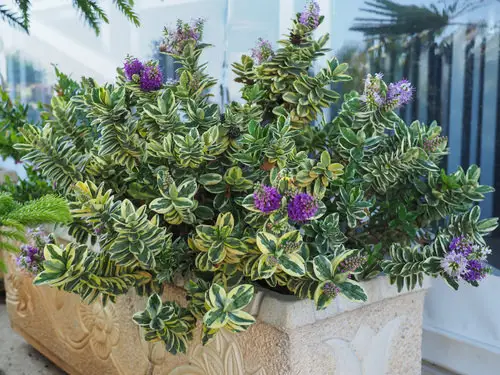
Botanical Name: Hebe
USDA Zones: 6-10
Pot Size: 10-14 inches
This small, prolific shrub grows up to 3 feet tall. Some Hebe shrubs have green leaves, while others have variegated leaves with splashes of white, cream, yellow, or pink. Growing Hebe in a container is easy, and it will flower in summer.
28. Hibiscus
Botanical Name: Hibiscus
USDA Zones: 5-11
Pot Size: 14-18 inches
Hibiscus is the most popular flowering shrub. Growing hibiscus in a pot is not difficult–all it asks for is plenty of sunshine and proper watering. Tropical Hibiscus is not frost hardy, so you’ll need to bring it indoors during the winter months.
29. Hydrangea

Botanical Name: Hydrangea macrophylla
USDA Zones: 3-11
Pot Size: 14-18 inches
With clusters of colorful flowers and big, dramatic leaves, Hydrangea is a stunning choice for a container garden. You should plant it in a large pot and provide regular watering. You can also grow them as specimens, hedge plants, and make a border with them.
30. Holly
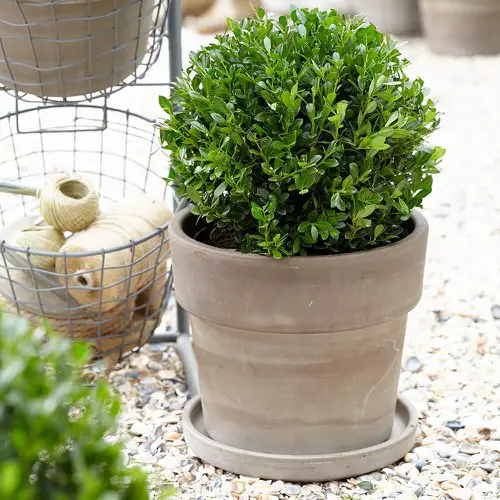
Botanical Name: Ilex
USDA Zones: 5-9
Pot Size: 14-18 inches
Growing Holly in containers requires care. It is better to choose a dwarf variety for a container garden–like Inkberry, Japanese Holly, or Sky Pencil. The flowers of Holly shrubs are produced in the early spring before the leaves. They are bright yellow.
31. Lantana
Botanical Name: Lantana camara
USDA Zones: 10-11
Pot Size: 12-16 inches
Lantanas are tropical climate shrubs and thrive on neglect. They are native to tropical regions of the Americas and Africa and bloom tirelessly throughout the year. Just give them fertilizer in spring and early summer.
32. Laurel Bay Leaf
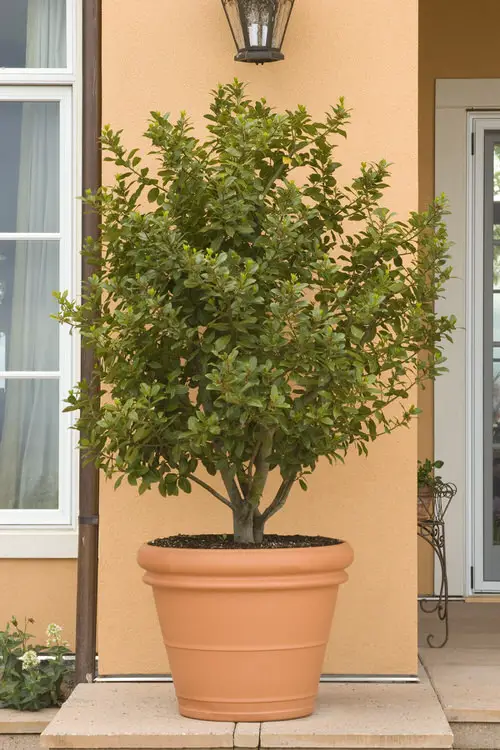
Botanical Name: Laurus nobilis
USDA Zones: 8-11
Pot Size: 14-18 inches
Bay Laurel is also a good choice for containers. It is prized for its glossy green leaves, which are widely used in cooking as a seasoning. Here’s everything you’ll need to grow Bay Laurel shrub.
33. Viburnum
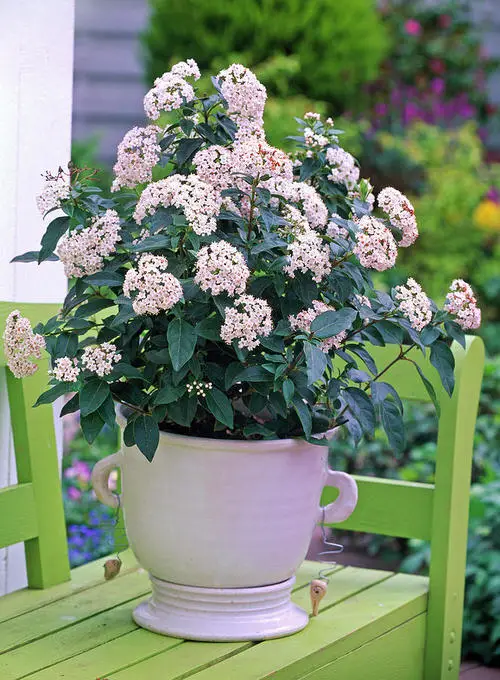
Botanical Name: Viburnum Tinus
USDA Zones: 7-11
Pot Size: 12-16 inches
Viburnum has pretty clusters of tiny flowers and grows well in containers. It has compact and bushy foliage and fills the air with a mild, sweet scent. You should go with Snowball or Cranberry viburnums–they’re the best and most popular.
34. Lavender
Botanical Name: Lavandula
USDA Zones: 5-9
Pot Size: 10-12 inches
Lavenders are easy to grow, and including them in your plant collection will turn your home into a fragrant one. And don’t even get us started on the lavender flowers. Lavender shrubs can vary in size depending on the species, but they’re usually 1-3 feet tall and wide.
35. Lilacs
Botanical Name: Syringa
USDA Zones: 4-9
Pot Size: 18-24 inches
If you love fragrance, you will love Lilacs. Get a pot that’s about a foot deep and about 2 feet wide and grow dwarf Lilies in it–like Bloomerang Lilac or Dwarf Korean Lilac. Lilac shrubs are deciduous, which means that they lose their leaves in the fall.
36. Magnolia
Botanical Name: Magnolia
USDA Zones: 6-10
Pot Size: 18-24 inches
Magnolias grow slowly, which means you can have one in the pot for a long time. But the best way to grow Magnolia in a container is to buy its dwarf shrub variety. Magnolias are relatively low-maintenance shrubs that prefer well-drained, slightly acidic soil.
37. Crepe Myrtle
Botanical Name: Lagerstroemia
USDA Zones: 7-10
Pot Size: 14-18 inches
Crepe myrtles come in many sizes, from dwarf varieties reaching 3-4 feet tall to larger types growing 10-15 feet tall. They’re perfect for pots. Make sure they get full sun to partial shade, and don’t prune them–they rarely need it.
38. Pittosporum
Botanical Name: Pittosporum
USDA Zones: 8-10
Pot Size: 12-16 inches
Pittosporum is great for a tall entryway container because it is lush and produces lovely flowers. The leaves are spirally arranged or whorled, simple, with an entire or waved margin. Look for the Silver Sheen, Nana, and Little Gold varieties.
39. Peony
Botanical Name: Paeonia
USDA Zones: 3-8
Pot Size: 12-16 inches
Peony flowers are large and can be single or double-petaled. Plus, the leaves are lush and it looks wonderful in containers. They are also considered to be a symbol of wealth, romance, and happiness.
40. Potentilla

Botanical Name: Potentilla
USDA Zones: 2-7
Pot Size: 10-14 inches
Potentilla thrives in containers! They grow 4-5 feet tall, so choose a well-draining pot and a sunny spot. The most popular one of these that’s used in landscaping is the Shrubby Cinquefoil (Potentilla fruticosa).
41. Rose
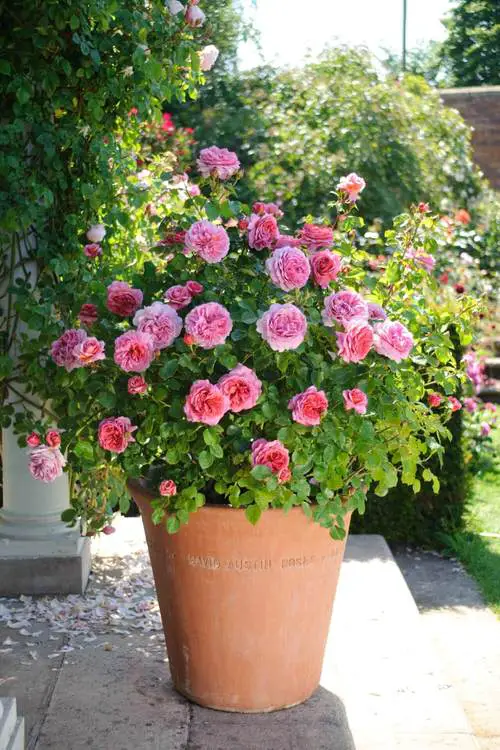
Botanical Name: Rosa
USDA Zones: 3-11
Pot Size: 12-16 inches
Planting shrub Roses in pots is a good idea. However, they require care and regular maintenance. You can read our rose care tips for help. Also, pick Floribunda or Grandiflora roses for containers. Hybrid tea roses are also good.
42. Rosemary
Botanical Name: Salvia rosmarinus
USDA Zones: 6-9
Pot Size: 12-14 inches
Rosemary is a highly aromatic perennial and a useful culinary shrub. Its beautiful blue-colored flowers and silvery-green foliage also make it an ornamental plant. Win-win. If you are looking for a low-maintenance, fragrant, and versatile shrub to add to your container garden, then Rosemary is for you.
43. Sedge
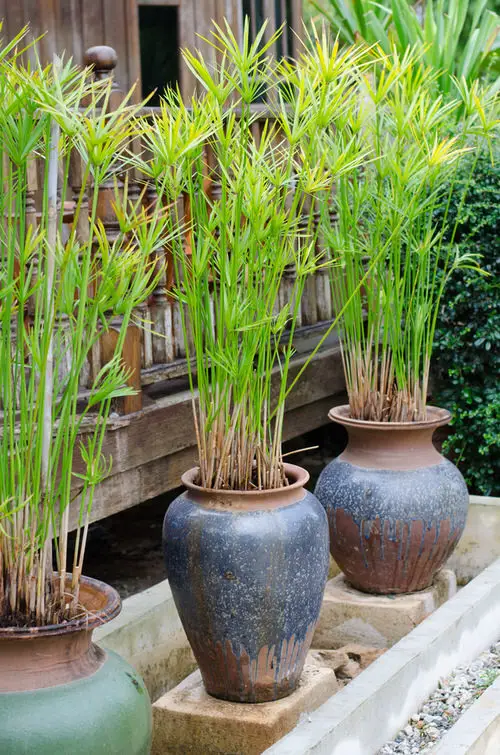
Botanical Name: Cyperaceae
USDA Zones: 4-10
Pot Size: 8-10 inches
Sedge is easy to maintain and looks great on a patio or terrace. Keep it in a sunny position in a temperate climate and under shade in the tropics. Its flowers are small and inconspicuous, and they are usually borne in spikes or clusters.
44. Spirea
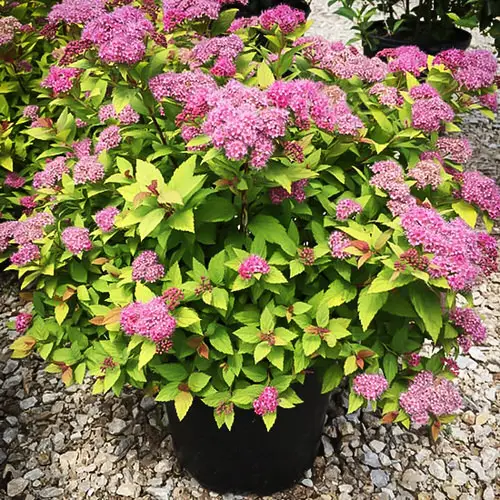
Botanical Name: Spirea
USDA Zones: 4-9
Pot Size: 12-16 inches
Dwarf varieties like Spirea Japonica “Nana” are ideal for growing in a container. They require slightly moist soil to grow. You can also use them in foundation plantings for year-round interest. They also make beautiful borders.
45. Japanese Skimmia

Botanical Name: Skimmia japonica subsp. reevesiana
USDA Zones: 7-9
Pot Size: 10-12 inches
Japanese Skimmia loves cool, shady spots in pots. Water it regularly and use acidic soil for its glossy green leaves and long-lasting red berries. It’s native to Japan, China, and Southeast Asia, but you can easily find it in a garden center near you.
46. Kalmia Latifolia
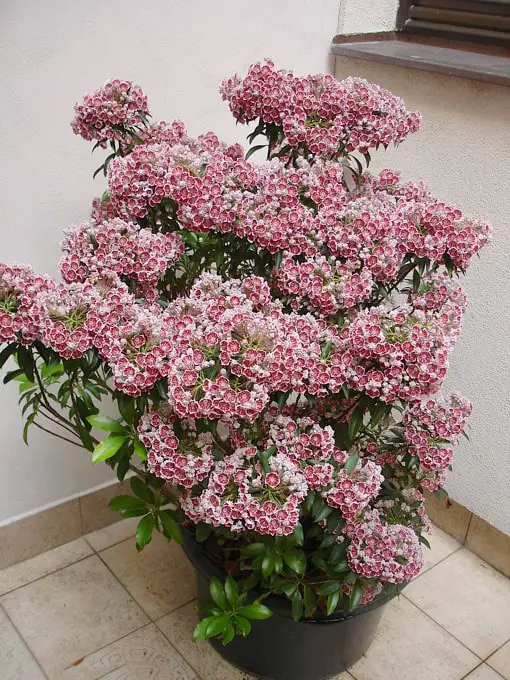
Botanical Name: Kalmia latifolia
USDA Zones: 5-9
Pot Size: 14-18 inches
This acid-loving shrub will give you huge clusters of bright red flower buds that open into strong pink blooms. ‘Little Linda’ is the best choice for containers. You need to know that all parts of the Kalmia latifolia plant are poisonous and can cause stomach upset, vomiting, and other problems if ingested.
47. Virginia Sweetspire

Botanical Name: Itea virginica
USDA Zones: 5-9
Pot Size: 12-16 inches
The Virginia Sweetspire has long, creamy white and green flower tassels. Keep the container in a sheltered spot and partial shade. In fall, the leaves of this shrub change their color and turn into pretty shades of red, orange, and gold.
48. Ninebark
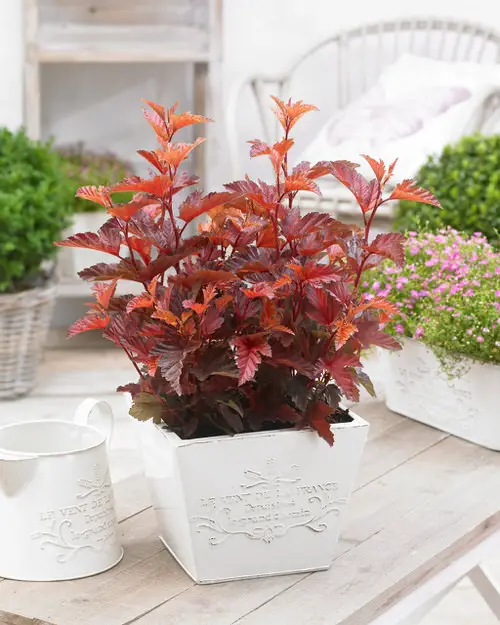
Botanical Name: Physocarpus opulifolius
USDA Zones: 3-9
Pot Size: 14-18 inches
Ninebark has a rust-colored foliage that turns everyone’s heads. A simple monochrome pot will surely uplift the foliage and make a great centerpiece. Ninebark gives springtime blooms, lush foliage in summer, vibrant fall colors in some varieties, and pretty exfoliating bark that provides winter interest.
49. Ixora

Botanical Name: Ixora coccinea
USDA Zones: 9-11
Pot Size: 12-16 inches
This low-maintenance shrub shows off clusters of red, pink, orange, and yellow florets that look like puffballs. It is also called Jungle Flame, Flame of the Woods, and West Indian Jasmine.
50. California Lilac
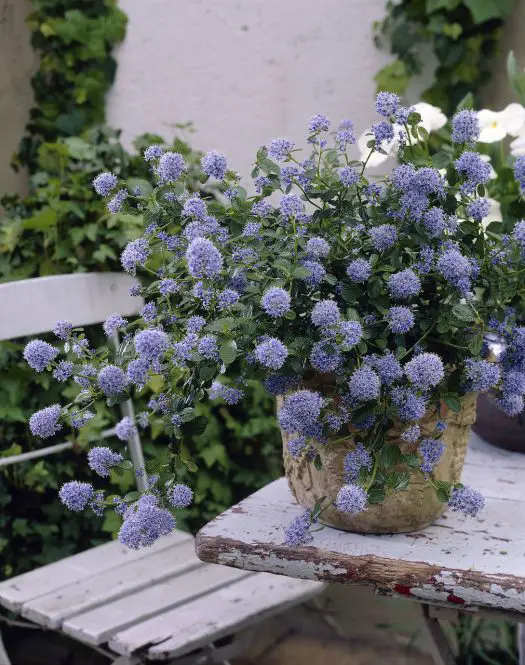
Botanical Name: Ceanothus
USDA Zones: 7-10
Pot Size: 10-12 inches
California Lilacs are native to California and bloom in late spring and summer. These blue flower shrubs for containers need full sun and well-drained soil. They are also drought-tolerant once established.


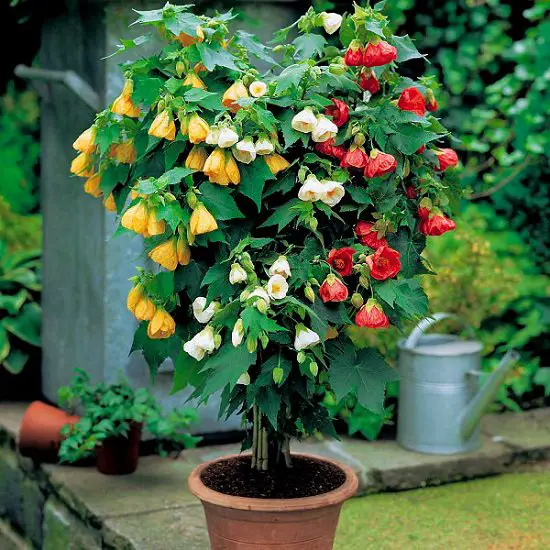
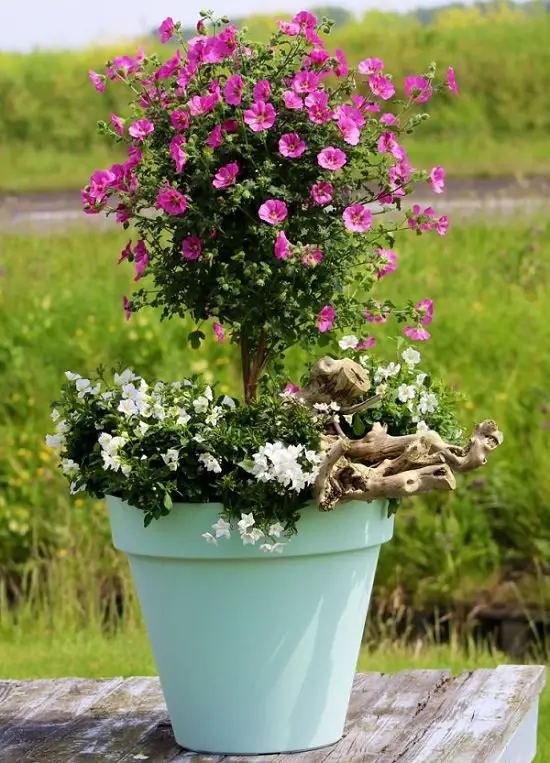
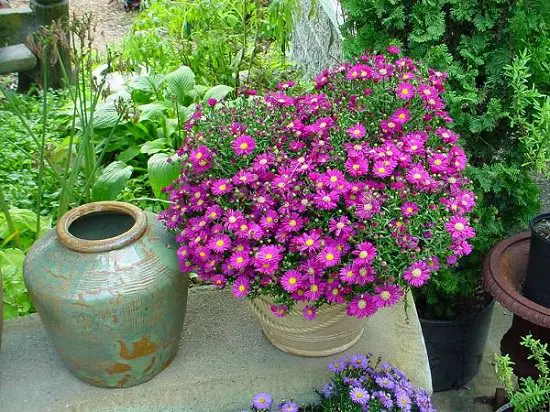
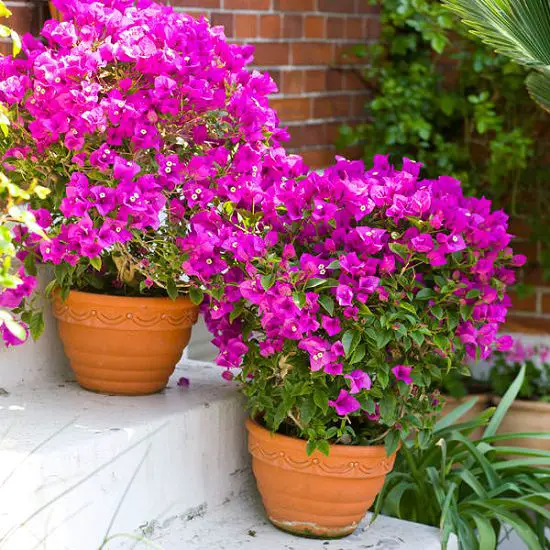
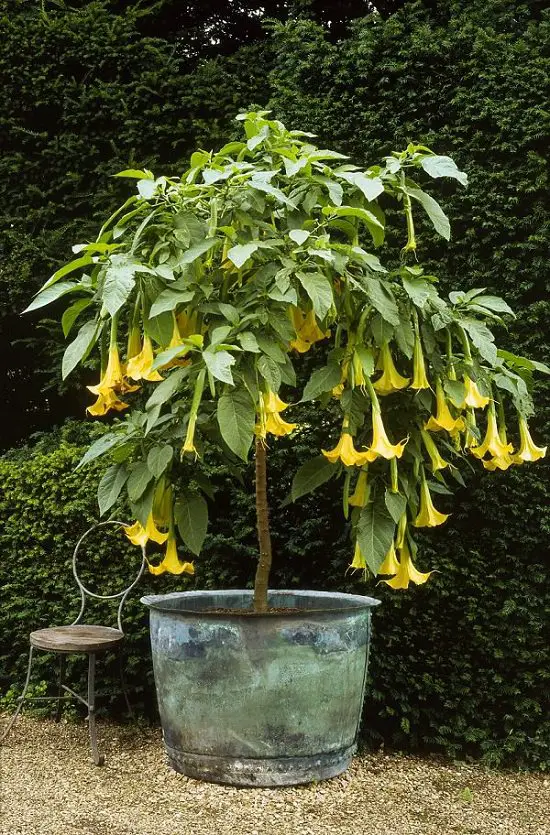
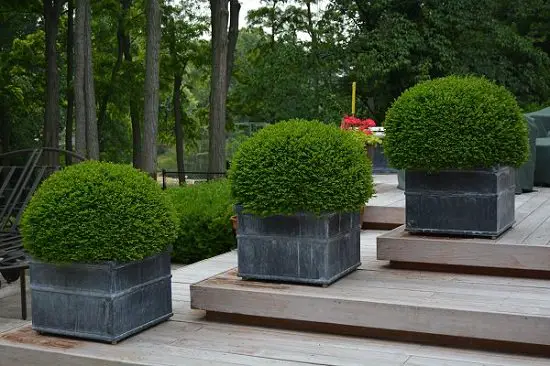
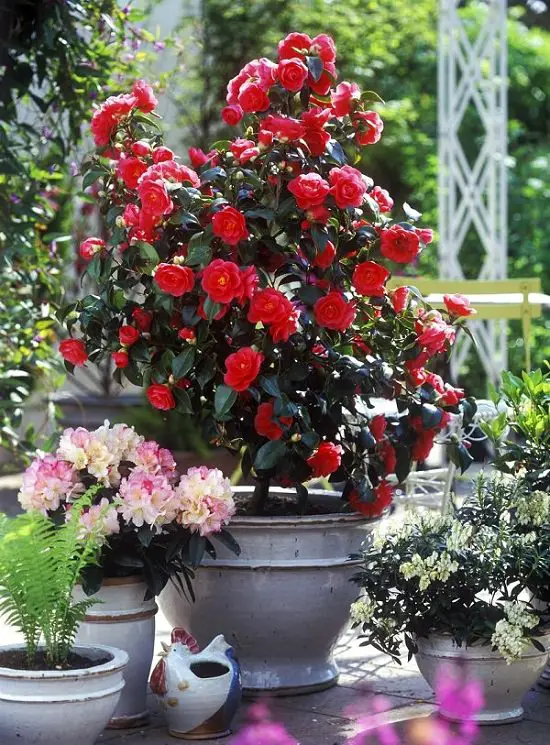

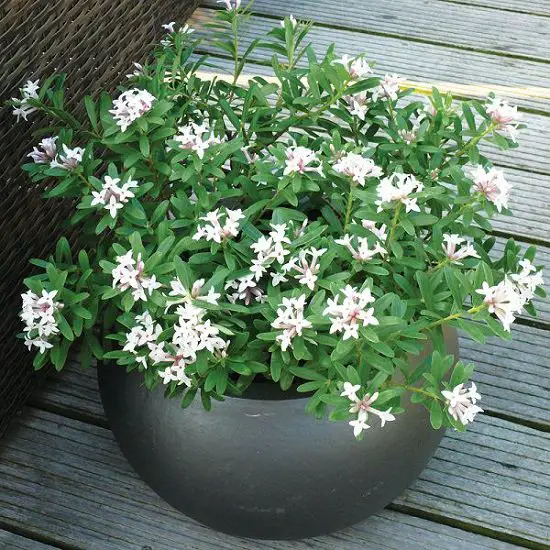
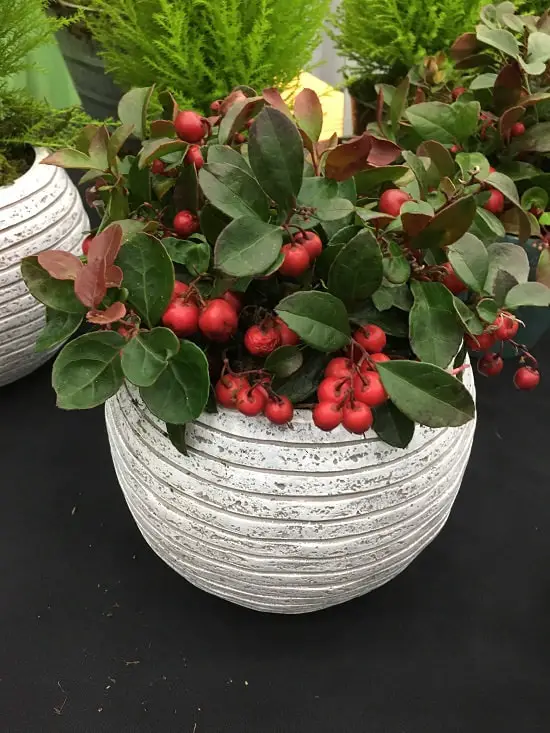
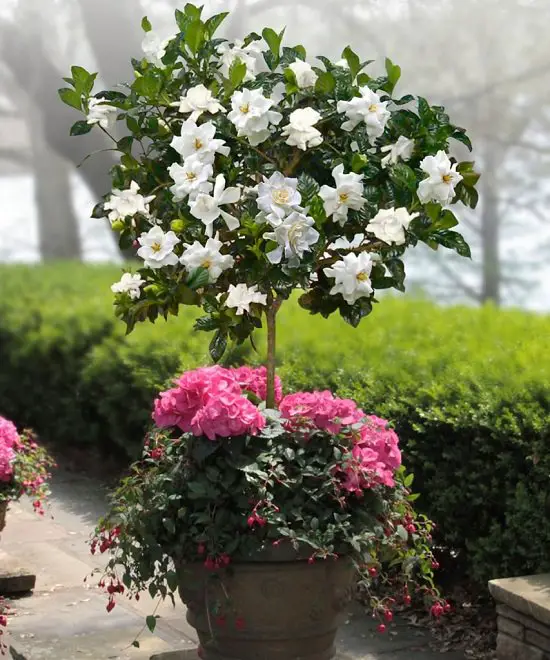
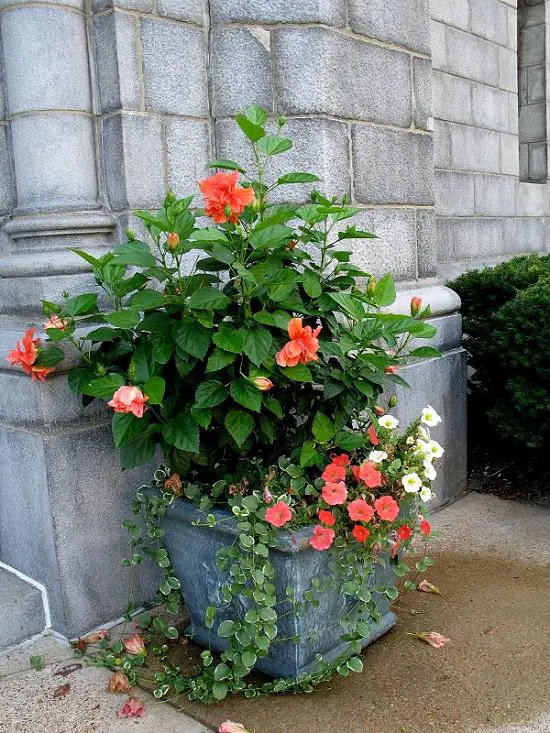

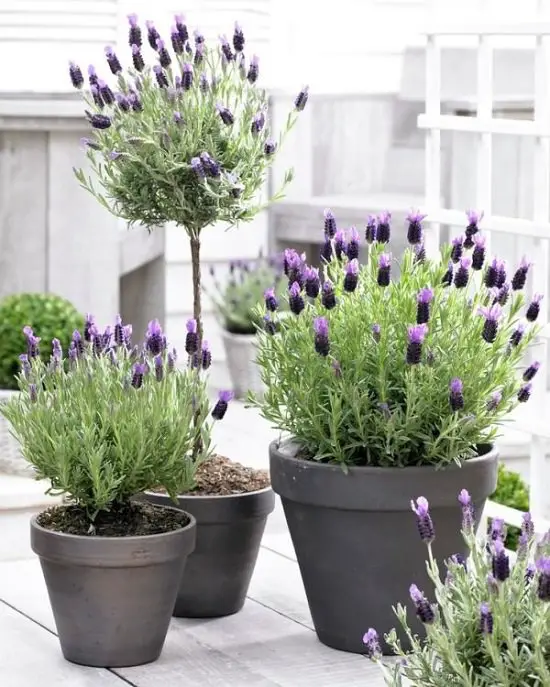

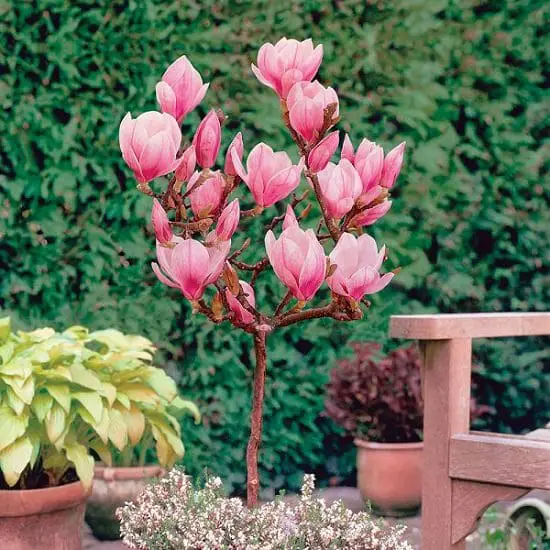
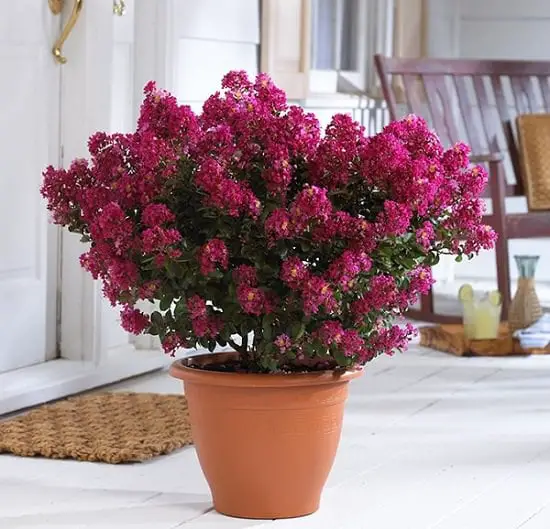
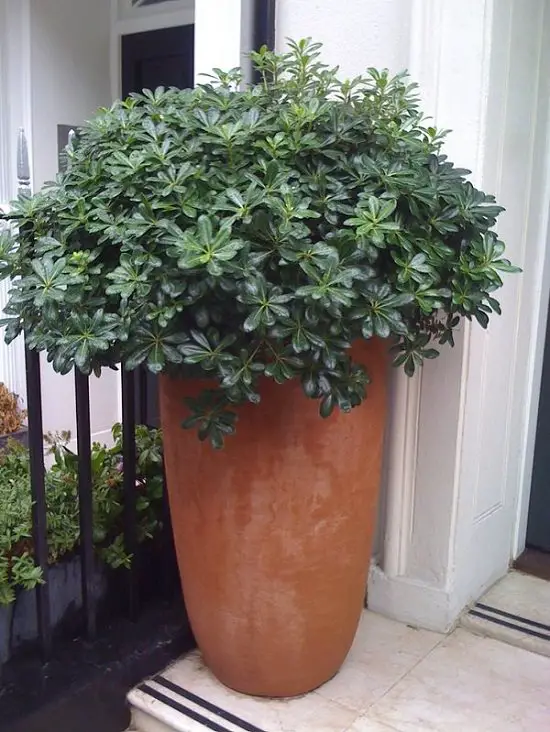



Do podocarpus grow in planters? I have a wall along my driveway that I’d like some privacy. The plant would need to be in a planter.
I love the Camellia. You say they grow well in mild summers but what about the winters? We have mild summers but the winters can be cold (up to -4). Will the plants need replaced every season or will they survive the winter?
You could get away with growing a camellia in a very sheltered spot in the ground in your area but for a container plant, you would have to winter it indoors in a cool but not freezing, well-lit room. Plants in containers are less hardy than plants in the ground because their roots are exposed to sub-freezing temperatures.
Will not survive -4 temperatures
I live in Canberra where the temp. can vary up to 43C in Summer down to minus 7C in the Winter. They are thriving under deciduous trees with plenty of Autumn leaves as ground cover. They flower well in season giving Winter colour and appreciating the Winter sunshine. I use when necessary a liquid fertiliser . They have been thriving and gradually turning into a hedge of 8 bushes over the 8 years since I first planted them.
I’m looking for part shade deck container plants, and full sun large bush plants that are deer proof, any suggestions?
This is so informative, thanks for sharing! I’m looking for some shrubs to decorate my patio with and will definitely be using some of these ideas. I love the andromeda in particular. I think it would grow really well in my climate. What size of planter would you recommend? I’m notorious for not giving my plants enough space!
Thanks for your help!
I must say I’ve never heard of many of these plants! I live in a small town and in the Northwest. I thought the article was well versed but can’t see buying any soon.
What pants and shrubs are deer resistant?
I have a very small garden and not much experience with shrubs ,can you recommend anything I can start of with.
I didn’t count 44, I only counted 13…is there more somewhere else???
At the bottom of the article, you have to tap on Page 1 to get to the beginning.
I was looking for some shrubs to grow for my porch. Your article was very informative.
What plant would do best in columbia,Mississippi
Very hot in summer sometime down to 23 in winter but no snow